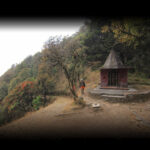Maha Saptami is celebrated every year on the seventh day of the waxing moon called ‘Shukla Paksha’ in the Hindu calendar month of ‘Ashwin,’ which falls on October 29 this year. The Maha Puja (Great Ceremony) starts on Maha Saptami. There is a Durga Puja, a Hindu festival, that takes place with great fanfare and celebrates the 10-armed goddess and her victory over the evil buffalo demon ‘Mahishasura.’
History of Maha Saptami
India celebrates a 10-day-long Durga Puja festival with great enthusiasm and spirit. Maha Saptami is day seven of that festival, and Saptami means ‘seven’ in Sanskrit. The Maha Puja of the Durga Puja begins on the day of Maha Saptami. It is said that the battle between Goddess Durga and the demon king Mahishasura began on this day and ended on Vijaya Dashami day, the 10th and last day of the Durga Puja festival with the victory of the goddess over the demon.
There is another legend surrounding the celebration of this day. It is believed that Lord Rama prayed to Goddess Durga before his battle with the demon king Ravana, who abducted his wife Sita. This puja had to be done with 100 blue lotus flowers; however, Lord Rama could only find 99. To complete the puja, he plucked out his own blue eye and offered it to the goddess in place of the missing lotus. Goddess Durga was pleased with this devotion and showered him with her blessings, which helped him win against Ravana. This battle happened on day seven of the month of Ashwin.
Durga Puja has traditional rituals associated with it, such as the Navapatrika, where nine plants are bathed in the River Ganges before the sun rises. These nine plants are turmeric, bel, Ashoka, ‘jayanti,’ pomegranate, banana, paddy, colocasia, and arum. The second ritual is the Mahasnan, where a mirror is treated as the personification of the Goddess Durga and is given a ritual bath. The last ritual is the Prana Prathishta, where a pot filled with holy water and covered with a coconut surrounded by five mango leaves is placed in front of the idol of the goddess, followed by chanting divine hymns. In the end, the goddess is worshipped using 16 special items.
Maha Saptami timeline
The first historic record of Maha Saptami celebrations is found in West Bengal, India.
A group of expatriate Bengalis organize the first community Durga Puja event in Delhi near Kashmiri Gate.
An 88-feet Durga Puja idol is made in Kolkata, West Bengal, and placed at their Deshapriya Park.
97 pandals in Cuttack, Odisha, India bedeck respective sculpture idols with silver jewelry for Durga Puja celebration
Maha Saptami FAQs
What is the meaning of Maha Saptami?
‘Maha’ means ‘Great’ and ‘Saptami’ means the ‘Seventh Day’. It is the seventh day of the waxing phase of the moon in the Ashwin month, during Durga Puja.
What do we do in Maha Saptami?
The traditions of Maha Saptami include a Maha pooja, which is done to worship Goddess Durga. This is also known as Durga Puja.
What happens on Saptami Durga Puja?
The Maha Saptami Durga Puja begins with a holy bath of nine plants that are bunched together. This is invoked as Goddess Durga in the river. This worship ritual is known as Nabapatrika. After this, she is respectfully placed on a pedestal that is embellished with ornaments and is graced with flowers, sandalwood paste, and incense sticks.
How to Observe Maha Saptami
Visit a Durga Puja festival
Durga Puja is celebrated widely in India and the Indian diaspora across the globe. Attend a Durga Puja festival and immerse yourself in the spirit of harmony and peaceful energies. Soak in the culture and see the celebration of a goddess.
Take time to reflect
Durga Puja is the victory of good over evil. Take this day to reflect and fight your inner demons. Let go of bad thoughts and negativity and allow positivity into your life.
Worship Goddess Durga
You can visit a local temple and worship Goddess Durga. If not, you can simply say a prayer at home and seek divine blessings and guidance in overcoming obstacles by keeping Goddess Durga in mind.
5 Important Facts About Maha Saptami
Durga Puja
Maha Saptami is the first day of the Durga Puja.
Celebrated in many states
Maha Saptami is part of the Durga Puja celebrations, which are celebrated largely in the Indian states of West Bengal, Assam, Tripura, Odisha, and Sikkim.
Rituals
Maha Saptami has three main rituals: the bathing ritual of nine plants, bathing of the mirror which reflects Goddess Durga, and worshipping the goddess with 16 special items.
Nabapatrika
Nabapatrika is a ritual that worships nine different leaves that are known to represent the nine forms of the goddess.
Kalratri
Goddess Kali is also known as Kalratri who is also another form of Goddess Shakti.
Why Maha Saptami is Important
It’s a religious festival
Maha Saptami is the first day of the Durga Puja festival that is celebrated with much fervor in some Indian states. People gather on the streets in large numbers and come together to take part in this religious festival. It gives people a platform to come together and be a community.
Celebrates women empowerment
Maha Saptami celebrates women empowerment in all its glory. According to the scriptures, Goddess Parvati gave up her golden avatar to kill the asuras Shumbha-Nishumbha. This is known as Kalratri.
It’s a celebration of victory over evil
Maha Saptami is when Goddess Kali defeated the demon Shumbha-Nishumbha. It is a sign of victory over evil. It shows how the good will always prevail over the bad, and we should keep fighting for what is right.
Maha Saptami dates
| Year | Date | Day |
|---|---|---|
| 2024 | October 10 | Thursday |
| 2025 | October 29 | Wednesday |















